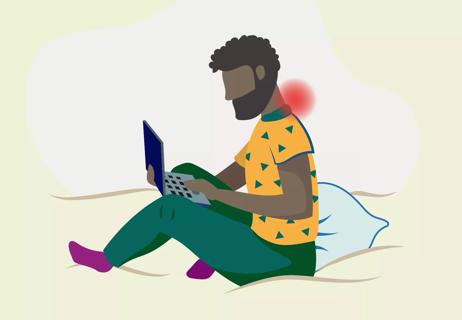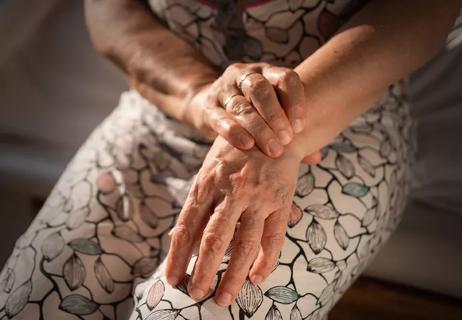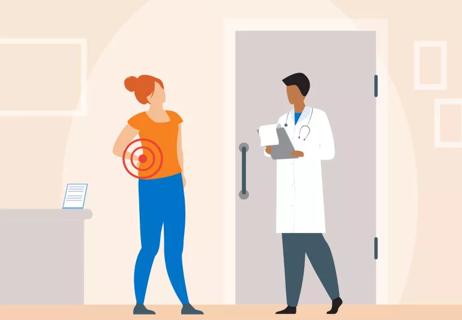Understanding cervical spondylosis

Just as years of walking and running take their toll on knees and hips, the cumulative stress of supporting the head — a weight roughly equal to that of a 10-pound bowling ball — wears on the disks and joints in our neck. As a result, nearly everyone ends up with arthritis of the neck, also known as cervical spondylosis.
Advertisement
Cleveland Clinic is a non-profit academic medical center. Advertising on our site helps support our mission. We do not endorse non-Cleveland Clinic products or services. Policy
“What happens is the disks start to degenerate, the bones collapse on each other, and bone spurs occur,” explains Thomas Mroz, MD, Director of the Center for Spine Health.
Every human being will have disk degeneration. Unfortunately, disks aren’t built to last. By age 60, about 90% of people will show some evidence of cervical spine degeneration on X-ray.
Pain is the most obvious symptom of a disk problem in the neck, yet the degree of damage has little to do with how much it hurts.
“You can have 100 people with the same amount of degenerative changes in their cervical spine, and only a small percentage have neck pain,” says Dr. Mroz. Among those who do experience neck pain, the discomfort is usually short-lived, improving on its own within six to 12 weeks.
Sometimes, cervical arthritis narrows the space where nerve roots exit the spine, pinching the nerve. You can feel this as a radiating pain down your arm, or as numbness and weakness in your arm and hand. If a collapsed disk or a bone spur pushes into the spinal cord and causes compression, it can produce more serious symptoms (like loss of hand dexterity, loss of balance, difficulty walking or bladder and bowel control issues.)
If you have neck pain, modify your activities for a few weeks to avoid putting additional strain on your neck. To relieve more severe pain, you can take an over-the-counter nonsteroidal anti-inflammatory drug (NSAID) or get a prescription from your doctor. The drug gabapentin (Neurontin®) may help with nerve-related neck pain.
Advertisement
If you don’t improve on these medications, your doctor might suggest an epidural steroid injection to decrease inflammation around and inside the nerve.
Once the pain subsides, Dr. Mroz recommends seeing a physical therapist or doing range-of-motion exercises to improve mobility in your neck and prevent stiffness. If you’re still having pain after six weeks, see a doctor.
For most people with arthritis of the neck, time and nonsurgical measures will relieve the discomfort. But if you have a herniated disk that causes spinal nerve compression with symptoms like pain, weakness and numbness that don’t go away, it may be time to consider surgery.
One way to surgically correct a pinched nerve is with a diskectomy. The surgeon removes part of the damaged disk to relieve pressure on the nerve. Then the vertebrae may be fused — or welded — together to stabilize the spine. Another surgical option is a posterior foraminotomy, which widens the opening of the spine where the nerve passes through, and removes any bone spurs that are pressing on the nerve.
Compression of the spinal cord can be treated several ways surgically. They all create more space for the nerves. Anterior decompression and fusion surgery is similar to the treatment of a pinched nerve. Cord compression can also be addressed by removing a part of the vertebra called the lamina or a procedure called a laminoplasty.
The vast majority of people with a pinched nerve will improve following surgery. “People with spinal cord compression also improve, but the extent of improvement depends on the severity of neurological dysfunction before the surgery,” says Dr. Mroz.
This article originally appeared in Cleveland Clinic Arthritis Advisor.
Advertisement
Learn more about our editorial process.
Advertisement

Here’s why it may be happening and how you can find some relief

Stretching or applying heat and ice can provide pain relief

Neck pain usually improves with simple measures

You can relieve this condition by improving your posture and using a variety of movements

Simple exercises like tendon glides and finger lifts can have a big impact

Safe to wear for most people, compression socks promote better blood circulation in your legs

Arthritis, migraines and endometriosis are common causes of chronic pain

Some creakiness is typical after rest, but longer-lasting stiffness may be other issues

Type 2 diabetes isn’t inevitable with these dietary changes

Applying a hot or cold compress can help with pain